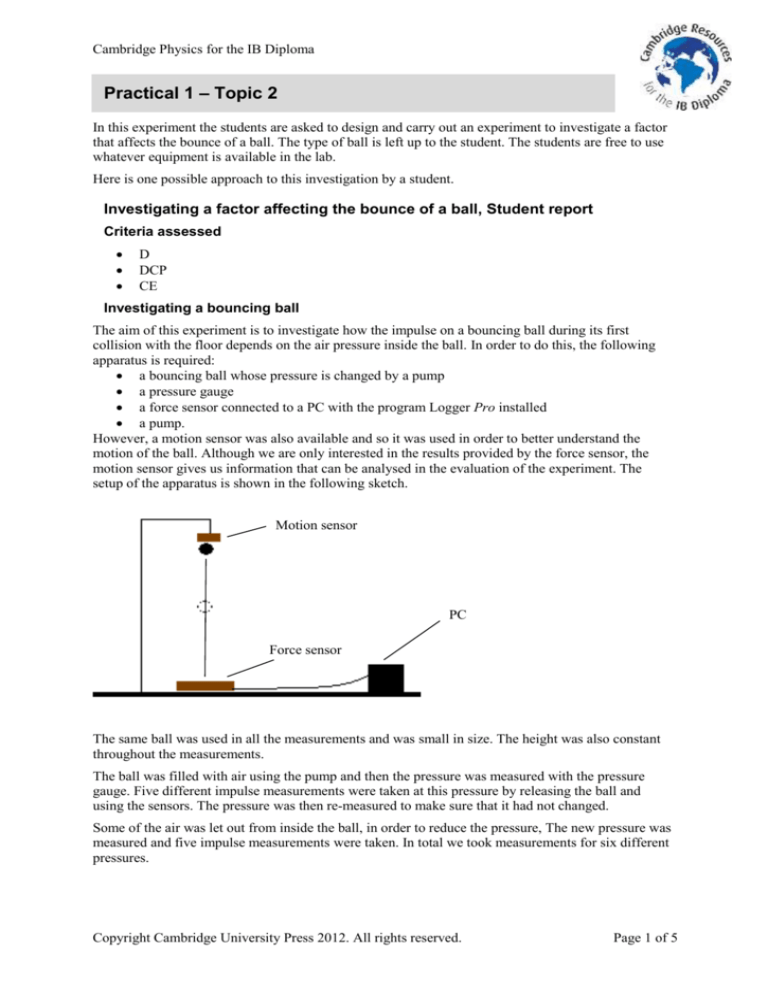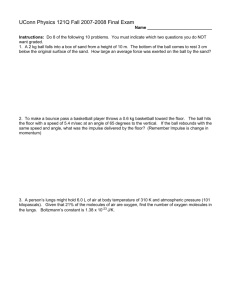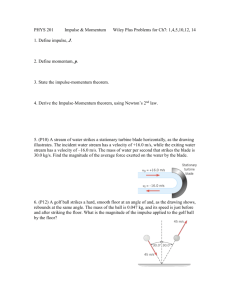
Cambridge Physics for the IB Diploma
Practical 1 – Topic 2
In this experiment the students are asked to design and carry out an experiment to investigate a factor
that affects the bounce of a ball. The type of ball is left up to the student. The students are free to use
whatever equipment is available in the lab.
Here is one possible approach to this investigation by a student.
Investigating a factor affecting the bounce of a ball, Student report
Criteria assessed
D
DCP
CE
Investigating a bouncing ball
The aim of this experiment is to investigate how the impulse on a bouncing ball during its first
collision with the floor depends on the air pressure inside the ball. In order to do this, the following
apparatus is required:
a bouncing ball whose pressure is changed by a pump
a pressure gauge
a force sensor connected to a PC with the program Logger Pro installed
a pump.
However, a motion sensor was also available and so it was used in order to better understand the
motion of the ball. Although we are only interested in the results provided by the force sensor, the
motion sensor gives us information that can be analysed in the evaluation of the experiment. The
setup of the apparatus is shown in the following sketch.
Motion sensor
PC
Force sensor
The same ball was used in all the measurements and was small in size. The height was also constant
throughout the measurements.
The ball was filled with air using the pump and then the pressure was measured with the pressure
gauge. Five different impulse measurements were taken at this pressure by releasing the ball and
using the sensors. The pressure was then re-measured to make sure that it had not changed.
Some of the air was let out from inside the ball, in order to reduce the pressure, The new pressure was
measured and five impulse measurements were taken. In total we took measurements for six different
pressures.
Copyright Cambridge University Press 2012. All rights reserved.
Page 1 of 5
Cambridge Physics for the IB Diploma
In order to calculate the impulse on the ball, we used the Logger Pro program. The force
sensor produced a graph of ‘Force’ against ‘Time’, similar to the following one, for each
different measurement. The following graph corresponds to a pressure of 91 kPa. The impulse
during the first bounce of the ball was measured as the area under the graph for the time interval of
the first bounce.
Clearly, however, the above measurement has a systematic error since the force sensor is recording a
positive value of force when nothing is in contact with it. Therefore, we have to subtract the area of a
parallelogram, which has t, the time of contact with the force sensor, as one side and the zero
reading as the other. The area subtracted is simply A = N0t and so the impulse value is
I = integral – N0t. Note that this systematic error did not occur in every measurement.
By doing the above process for each different measurement, we were able to obtain values of impulse
for each different pressure. The following graph contains measurements for each different pressure
value.
Clearly, at lower pressures the force felt by the ball does not change significantly. However, from the
above graph one cannot distinguish the effect of the systematic error, which is present in some of the
measurements, on the force value.
Copyright Cambridge University Press 2012. All rights reserved.
Page 2 of 5
Cambridge Physics for the IB Diploma
Collected data
The following table contains five different values for the impulse felt by a bouncing ball on its
first collision with the floor for different values of pressure inside the ball. These values of impulse
were calculated using the previously explained method. Pressure values, as measured by the pressure
gauge, are also shown.
Pressure (kPa)
99.0
51.0
31.0
26.0
21.0
16.0
1st impulse measurement (N s)
1.294
1.284
1.227
1.226
1.208
1.191
2nd impulse measurement (N s)
1.297
1.261
1.247
1.201
1.234
1.179
3rd impulse measurement (N s)
1.304
1.277
1.230
1.203
1.232
1.183
4th impulse measurement (N s)
1.283
1.254
1.228
1.185
1.183
1.194
5th impulse measurement (N s)
1.316
1.269
1.225
1.236
1.180
1.159
The following table contains an average value of the impulse for the different values of pressure. The
absolute uncertainty of each impulse value I is found by calculating the standard deviation of the
five different impulse values. The absolute uncertainty of the pressure value is assigned to 1 kPa,
since there is an important rounding error related to the value displayed by the pressure gauge.
99 ± 1
51 ± 1
31 ± 1
26 ± 1
21 ± 1
16 ± 1
Average impulse (N s)
1.30
1.27
1.23
1.21
1.21
1.18
ΔΙ (±)
0.01
0.01
0.01
0.02
0.03
0.01
Pressure (kPa)
The above data can now be plotted on a graph of ‘Impulse’ against ‘Pressure’. The appropriate
uncertainties are also shown. A power fit seems to be the best attempt of curve fitting. The fit is
successful since the curve plotted passes through the uncertainty bars of all values. The value of the
root mean square error (RMSE) is low, which shows that the curve fitting is successful.
Copyright Cambridge University Press 2012. All rights reserved.
Page 3 of 5
Cambridge Physics for the IB Diploma
Conclusion and evaluation
The measurements we made allowed us to plot a graph of ‘Impulse’ against ‘Pressure’ in
order to investigate how the impulse on a bouncing ball during its first collision with the floor
depends on the air pressure inside the ball. The graph was successful since the curve passed through
the error bars of all points and the root mean square error was significantly low. The power fit was
successful; however, the fact that the relation between impulse and pressure turned out roughly to be
I = cP1/20 kPa, where the pressure is measured in kPa, implies that the physics related to our
investigation is quite complicated.
There are many different factors that affected our experiment.
First of all, when measuring the pressure inside the ball, some of the air may have escaped while
inserting and removing the pressure gauge, which means that the pressure inside the ball might have
been different from the value measured. In an effort to control this effect we measured the pressure of
the ball both before and after taking the measurements; if a significant change was observed we
restarted the process.
The height from which the ball was released was assumed constant, although this was not always the
case. An effort was made to ensure that the ball was released exactly below the motion sensor.
However, as the following ‘Position’ against ‘Time’ graph, shows, the ball’s distance from the motion
sensor seems to change due to the instability of the hand holding it. This graph was produced with the
help of the motion sensor. A systematic error is also easily visible on the graph. However, the effect
of such differences is negligible since the height is much larger than the small differences in the
distance from the motion sensor.
Our experimental setup also allowed us to obtain other interesting information. For instance, the graph
above allows us to measure the distance between the motion sensor and the force sensor – after about
1.3 s no object is between them. Even more interestingly, we can measure the diameter of the ball
since it is equal to the difference in the distance from the motion sensor measured at the time of the
collision (at the peak of the below graph, 0.9 s) and once no object is between the two sensors (after
1.3 s).
Another important factor is that the surface of the ball was not uniform, therefore the collisions cannot
be considered identical. Additionally, certain points on the surface of the ball are sharper than others,
especially where the different parts of the ball are stitched together. A sharper edge affects both the
time of contact with the floor and the force exerted on the ball.
Additionally, as air is pumped into the ball, more molecules of air are now concentrated inside the
ball, increasing its mass. Nevertheless, this effect is also negligible since the mass difference is very
small in comparison to the mass of the ball. Furthermore, air resistance is not negligible. Its effect
would not interest us if it were the same for each different measurement; however, the value of the
resistive force is not constant for each measurement, which affects the speeds with which the ball
reaches the force sensor.
One can always evaluate the effectiveness of the sensors. The fact that the force sensor seems to
produce different systematic errors from measurement to measurement shows that it is not completely
reliable. Differences in room temperature may affect the way the sensors function. Additionally, the
small size of the ball makes the motion sensor quite inaccurate since it is unable to detect the ball the
Copyright Cambridge University Press 2012. All rights reserved.
Page 4 of 5
Cambridge Physics for the IB Diploma
further away it moves. Since the surface of the ball is not planar, the motion sensor receives
waves from different parts of the ball, which are at different distances from it. One must also
note that the ball was not always released vertical to the force sensor, which certainly affects
the measurements. This can be easily seen from the two following graphs. In the first graph, the ball
falls almost vertically and so many bounces are shown. In the second graph the ball seems to rebound
from the force sensor at an angle, so that no more bounces are shown.
A very important effect, which is also observable in the above graphs, concerns the forces exerted on
and by the force sensor. As the ball collided with the force sensor, it exerted a force on it. In turn the
force sensor exerted this force on the floor and by Newton’s third law the floor exerted an equal force
in the opposite direction on the force sensor. This force accelerated the force sensor upwards, which
certainly affected the force measurements.
Finally, one must comment that although five measurements for each pressure and in total six
different pressure values give adequate data, processing them created undesired errors. When using
the Logger Pro to calculate the area under the graph, we had to specify the boundaries between which
the area was to be measured, in order to only consider t, the time of contact with the force sensor.
These boundaries did not always correspond to the values desired, which are the first instant of
contact of the ball with the force sensor and the instant the ball loses contact with the force sensor.
The fact that we had to add or subtract the systematic error, which was not easily read, made this
effect even more important.
Copyright Cambridge University Press 2012. All rights reserved.
Page 5 of 5









